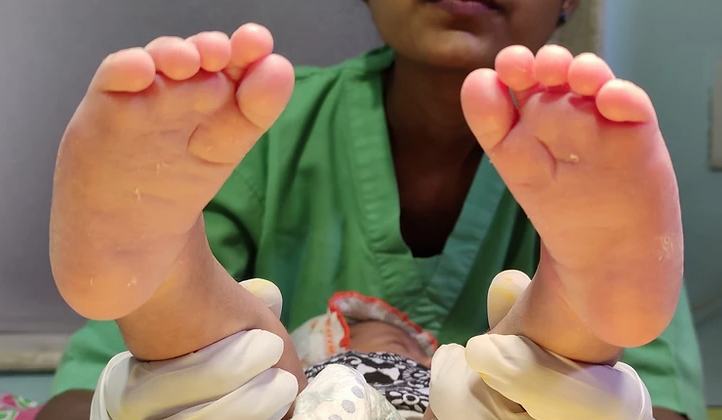Clubfoot or Congenital Talipes Equinovarus (CTEV)

Rickets – All You Need to Know
December 28, 2019
Clubfoot refers to a condition in which a newborn’s foot or feet appear to be rotated internally at the ankle. The foot points down and inwards, and the soles of the feet face each other. It is the most common deformity of the bones and joints in newborns. It can be mild or severe and occur in one or both feet.
The cause of clubfoot is not exactly known, but it is most likely a genetic disorder and not caused by anything the parents did or did not do. Therefore, there is no reason for parents to feel guilty about having a child with clubfoot. Nearly 1 in 1000 babies is born with this condition. 50% of the children affected with this condition have both of their feet affected.
The chances of having a second child with a clubfoot are approximately 1 in 30. In babies who have clubfoot, the tendons that connect their leg muscles to their heel are too short. These tight tendons cause the foot to twist out of shape. Parents of an otherwise normal infant who is born with clubfoot can be reassured that their baby, when treated by an expert in this field, will have a normal-looking foot with essentially normal function. Consult Dr. Ratnav Ratan, a pediatric orthopedic doctor in Gurgaon at the W Pratiksha Hospital.
Diagnosis
The condition is usually diagnosed at the time of birth during physical examination. It can also be detected before birth by ultrasound, especially if both feet are affected. If it is detected before birth, no treatment is possible until after the baby is born.
In some cases, also known as Atypical Clubfoot, the baby may have associated congenital abnormalities like Arthrogryposis, Muscular Dystrophy, Spina Bifida etc.
Risk factors
- Male children are at higher risk of developing this abnormality when compared with female children.
- Genetics has a major role to play in this condition, children who either have one or both their parents who had condition at their time of birth are more likely to suffer from this.
- Too less of amniotic fluid (Oligohydramnios) in the uterus can also increase the risk of the condition.
- Recent researches attributed the condition to genetic mutation
- Smoking during pregnancy
Treatment
The condition does not resolve without treatment and will only worsen with progressing age, if left untreated. The commonest treatment form is manipulation of the feet through stretching and using special casts to keep the alignment of the feet as normal as possible. The most widely used is called the Ponseti method. This may be done over a span of few months, requiring multiple and prolonged usage of special boots. The younger the age at which the treatment is initiated, sooner and better the cure. Hence, it is advisable to initiate the treatment right after birth.
The Ponseti casting technique
With the ponseti technique, stretching is used in combination with a cast. Our paediatric orthopaedic specialist will stretch your baby’s foot toward the correct position and then a plaster cast is applied from the toes to the thigh, to hold the foot in position. There is normally one session a week. The manipulation and casting are done very gently, and the baby experience no pain. At each session, the plaster cast is changed, and each time the foot is corrected a little more. The whole process may be done 4 to 10 times, using 4 to 10 new casts.

Sometimes, the doctor will also need to release a portion of the Achilles tendon via a minor surgery that connects your baby’s heel to his or her calf muscle. Doing so will allow the tendon to grow to a normal length. If this is required, the doctor will do the clipping before putting on the baby’s final cast.
Once the final cast is off, the baby will need to wear special boots (Denis Brown splint) for 3 months, the boots are worn 23 hours a day. After this, they are only worn at night and during daytime naps, until the age of around 4 years. Parent will also need to continue doing stretching exercises .

Adhering to the prescribed usage guidelines for the special boots are extremely important, not following the guidelines correctly is the commonest cause of failure of this treatment method.
Cases not responding to non-invasive treatment methods might demand for surgical approach. The aim of the surgery is to lengthen the tendons so that the feet are easier to move. In most of the cases the children grow up to be completely normal with proper developmental milestones and gait.
Prevention
There’s no prevention for this condition. The only prevention strategies can be the following:
- avoid first-hand or second-hand exposure to smoking completely
- avoid alcohol consumption
- do not take any medication without a doctors’ prescription
Complications
The well-treated clubfoot causes no handicap and the individual is fully able to live a normal active life. Left untreated, however, complications can occur. There will usually be no pain or discomfort until the child comes to stand and walk. It will be hard to walk on the soles of the feet. Instead, the child will have to use instead the balls of the feet, the outside of the feet, and in very severe cases the top of the feet.
There is a long-term risk of eventually developing arthritis. The inability to walk properly can make it difficult for a person with clubfoot to participate fully in some activities. The unusual appearance of the foot may also cause self-image problems.
Even with treatment, the foot will be between one and one-and-a-half times smaller than the other foot, and slightly less mobile. The calf of the leg will also be smaller.
If your child is suffering from clubfoot or CTEV (Congenital talipes equinovarus) Book your child’s appointment today!



